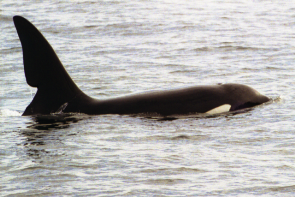Extinction looms for last resident killer whale pod in Scottish waters
FOR at least three decades they have made the waters off the west of Scotland their own, delighting visitors and residents alike. But now it seems the country’s only resident pod of killer whales is doomed to extinction and pollution could be to blame. The nine whales have failed to produce a single surviving calf in 20 years and Dr Andy Foote, a world-renowned expert on orcas, believes time has run out for the four males and five females. The marine biologist has been studying the group, known as the West Coast Community, with the Hebridean Whale and Dolphin Trust and the Irish Whale and Dolphin Group, since 1992. He said: “It’s probably too late to save this group. I do believe that they will become extinct in our lifetime which is very regrettable since not many people even know that such a distinctive group of killer whales exist just off our coast.” Little is known about the isolated community, but Foote and the NAKID (North Atlantic Killer Whale ID) project have tracked the group using distinctive fin and body markings and scars to identify them as they move around their home territory. Since 1981, around 255 sightings of the killer whales have been reported by members of the public from Mull to Tiree and Coll. Sightings have even been recorded off the west coast of Ireland and Wales. Although there are regular sightings of other orcas off north-east Scotland, the west coasters are believed to be the only resident community – meaning they live in Scottish waters all year. Observers have even named the community members, calling the males John Coe, Floppy Fin, Comet, and Aquarius. The females are Nicola, Lulu, Moneypenny – she is numbered 007 in the group – Puffin and Ocassus. John Coe, named after a famous explorer, seems the most famous member of the soon-to-be-extinct family – perhaps because he has the most distinctive looking dorsal fin. An adult male, Moon, has already disappeared and Foote fears this is just the beginning of the problems that the orcas face. He believes contaminants could be one of the factors that has stopped the pod from successfully breeding. “Female orcas store contaminants in their body fat and they pass some of the pollutants in their bodies to their calves when they’re feeding. This is another possible reason why there have been no live calves seen.” Foote and the HWDT are appealing to the government for help. He said: “Fire retardants, pesticides and industrial manufacturing chemicals can end up in the water and it is likely that this is causing problems for the west coast group. If we successfully pass legislation that will reduce the amount of contaminants in the water, other countries will look to that and use us as an example, which could in turn help their populations of killer whales.” Such steps are almost certainly too late for John Coe and the rest of the group. “With large animals like these, the hope of saving them is quite slim. We know they are decades old and the possibility of something like artificial insemination is very unlikely. […]
